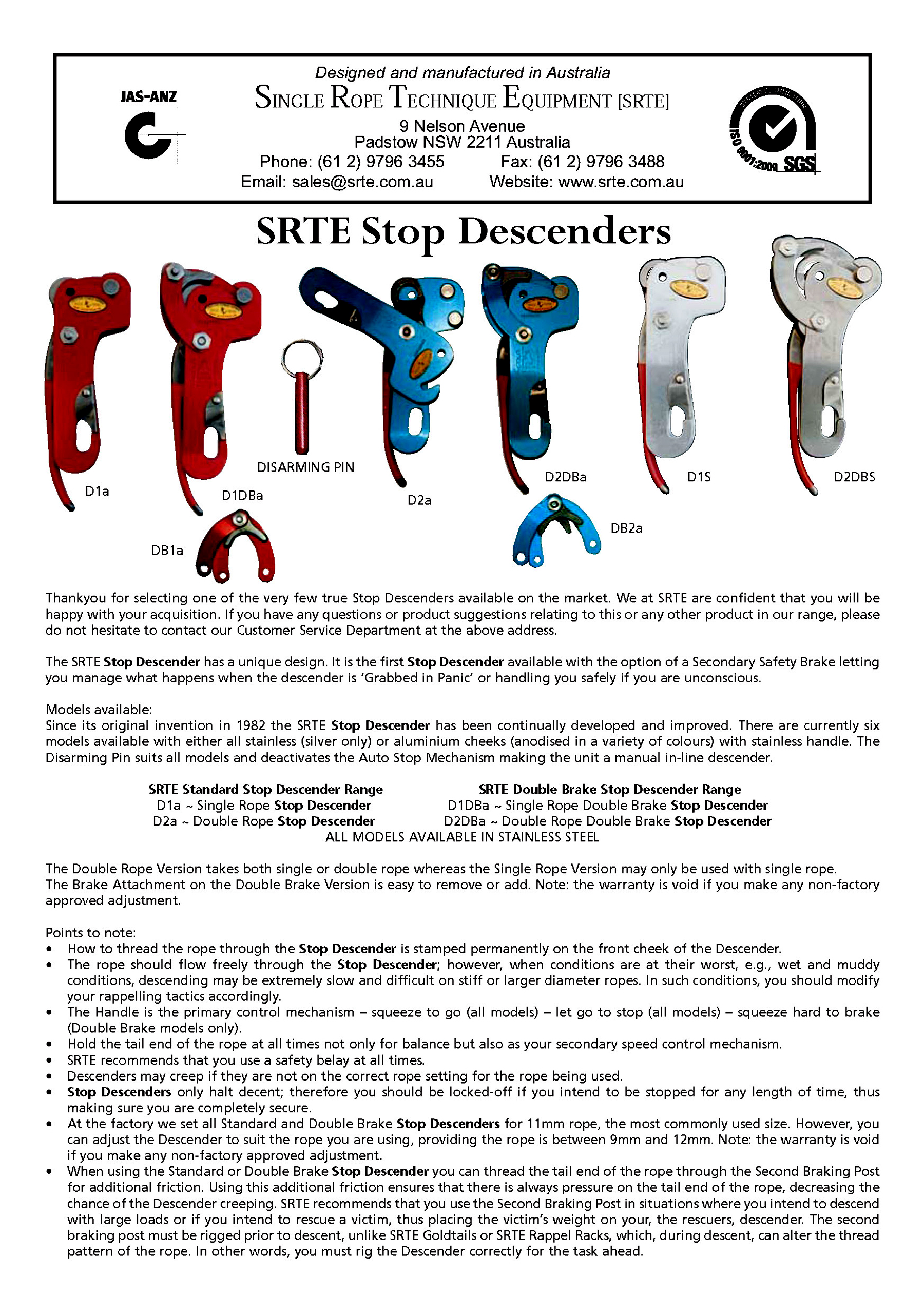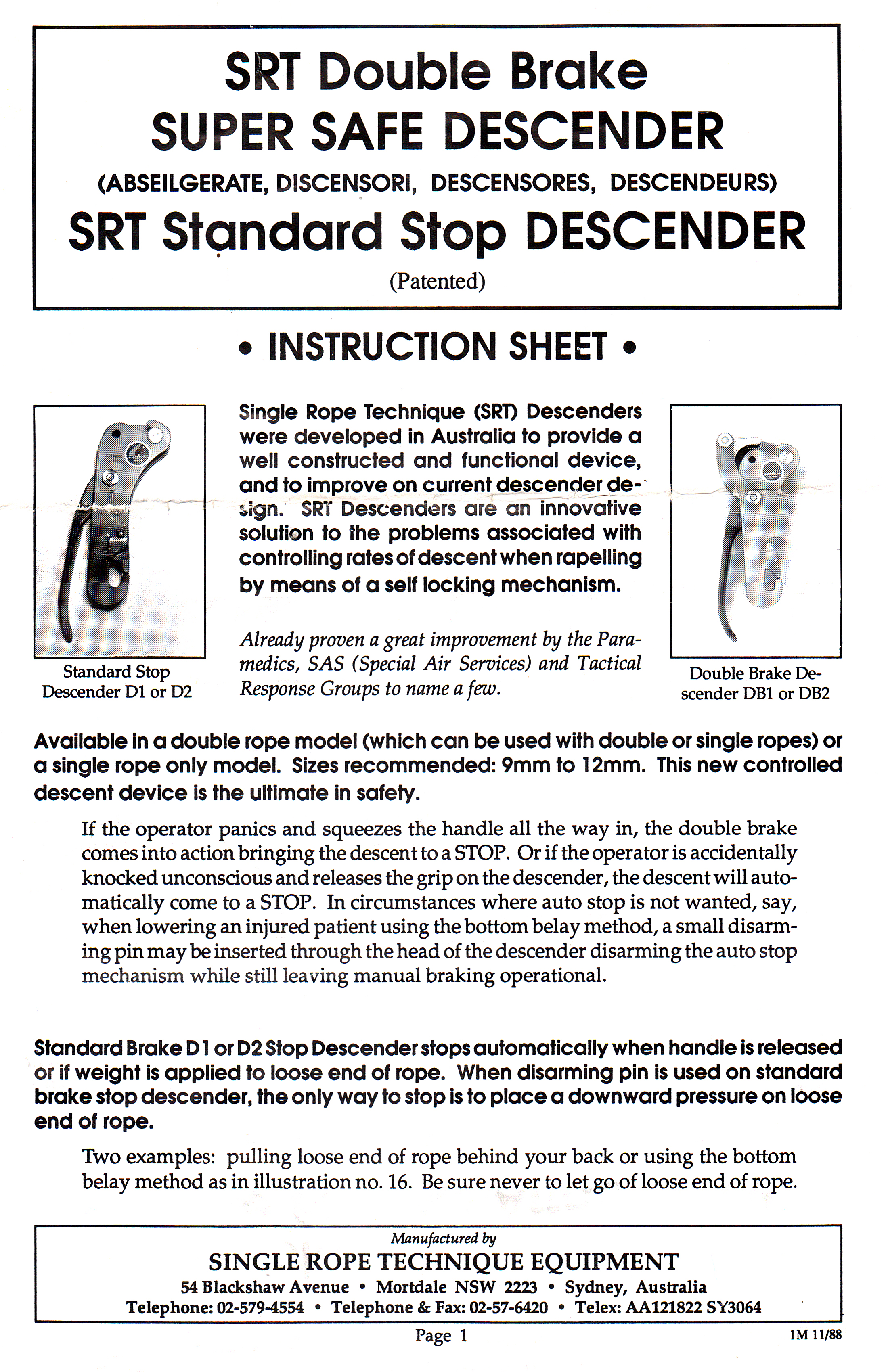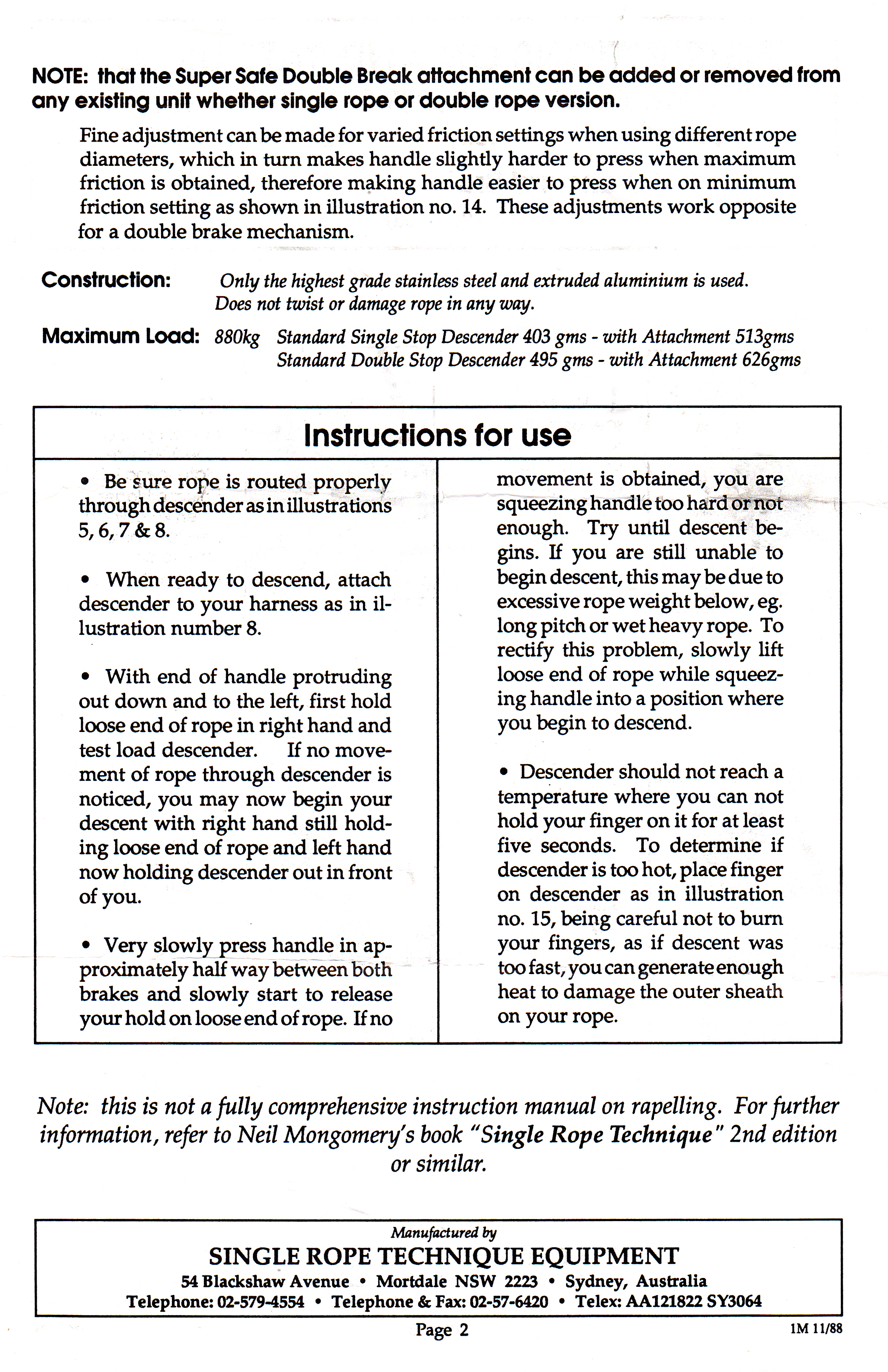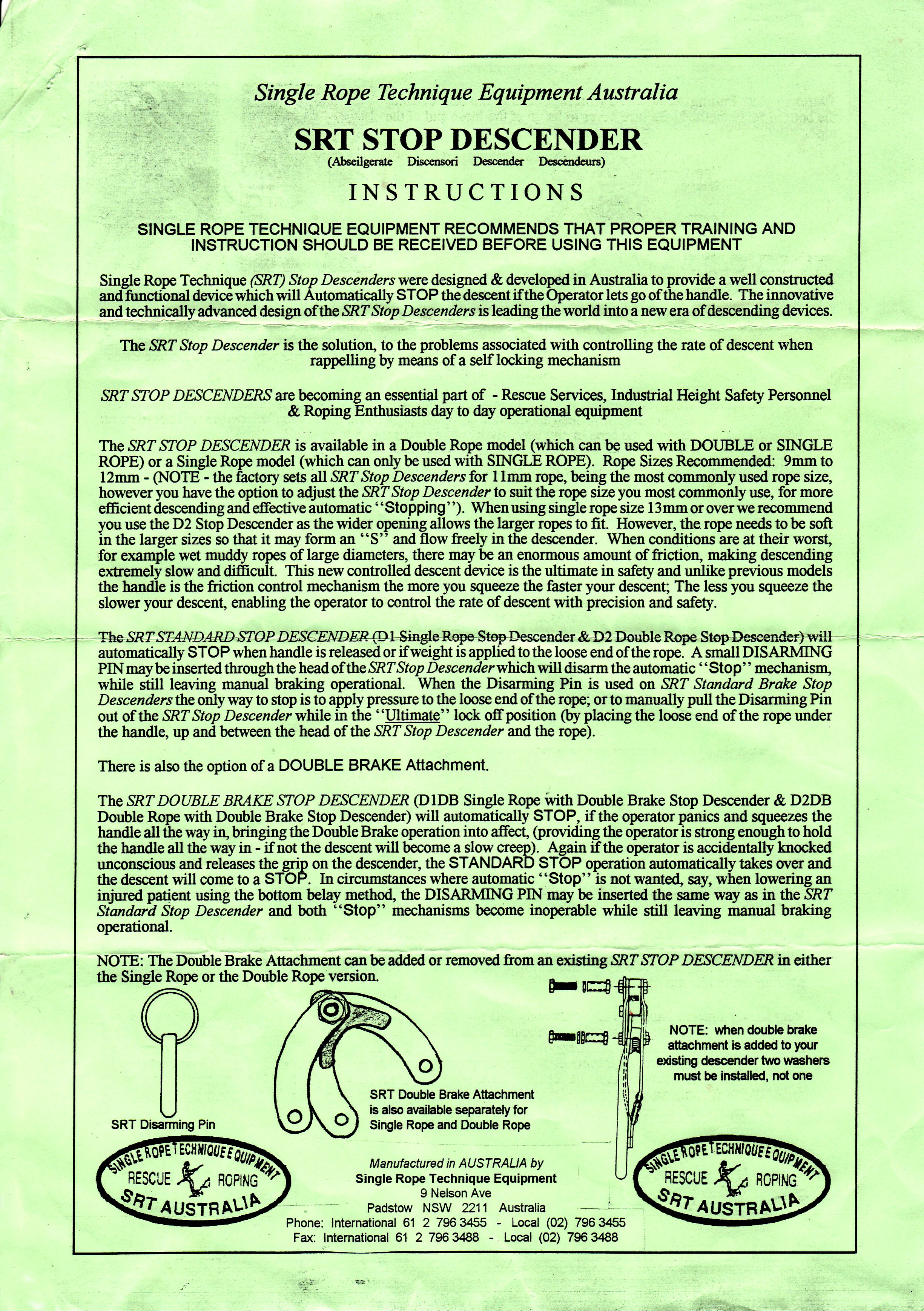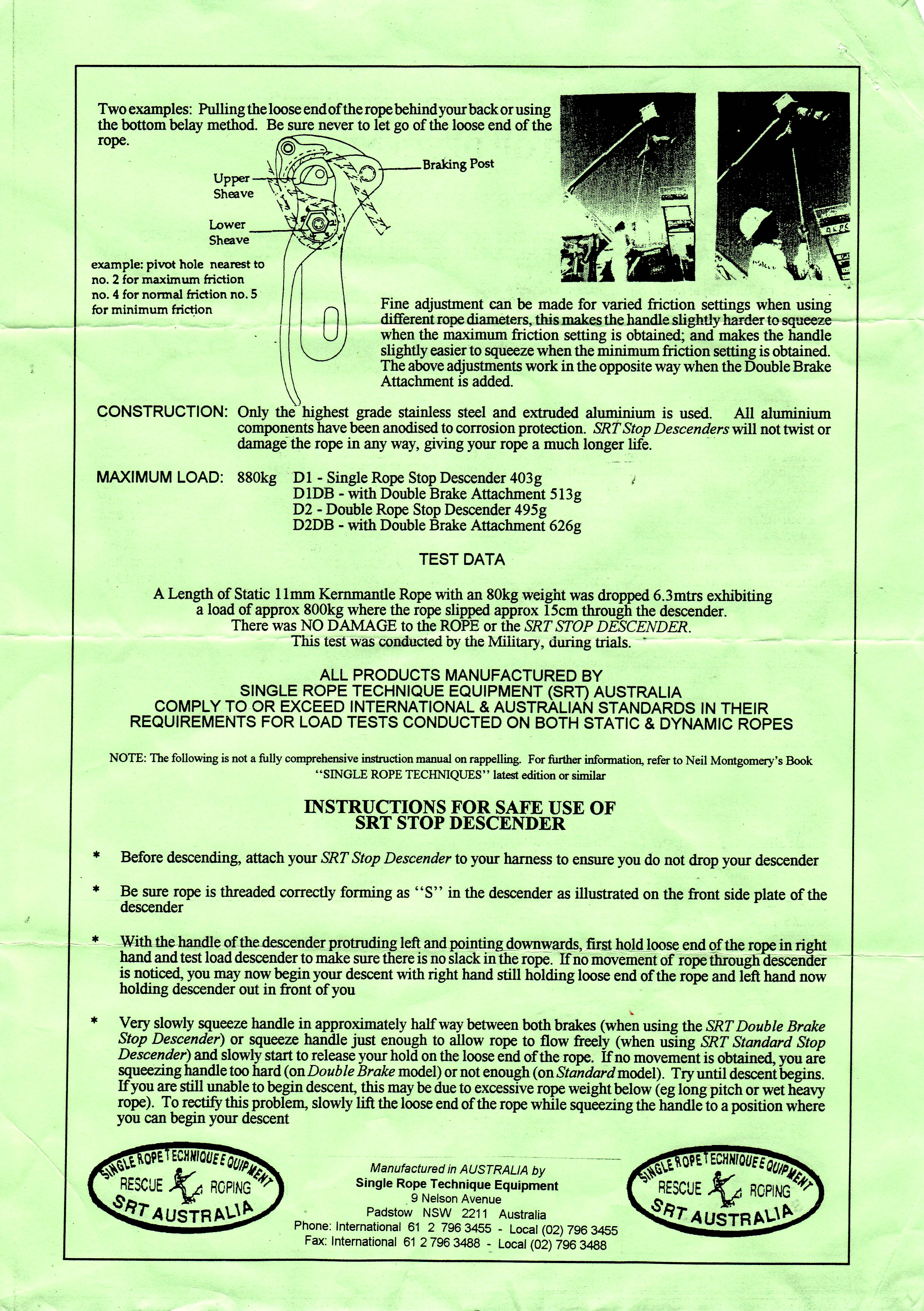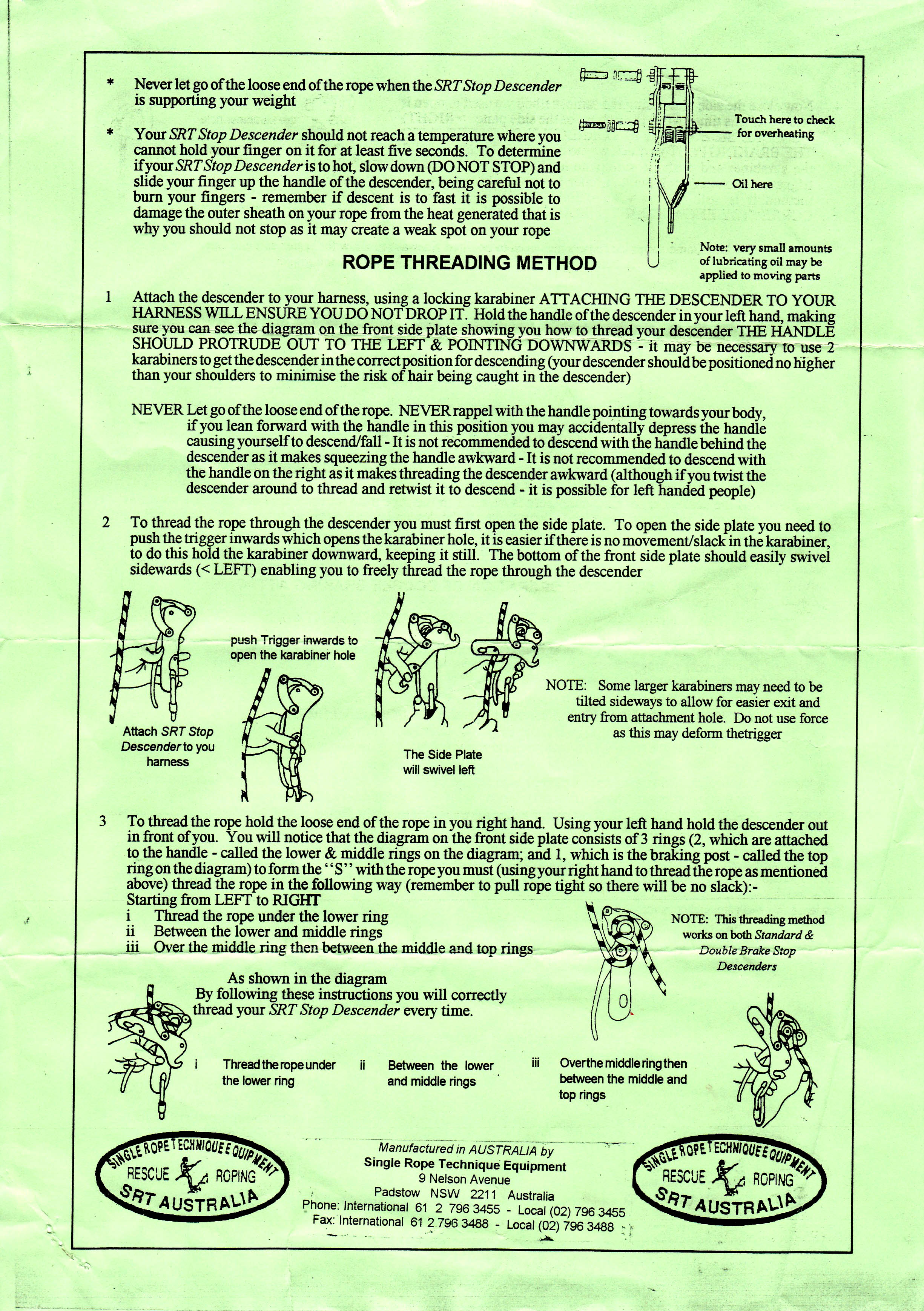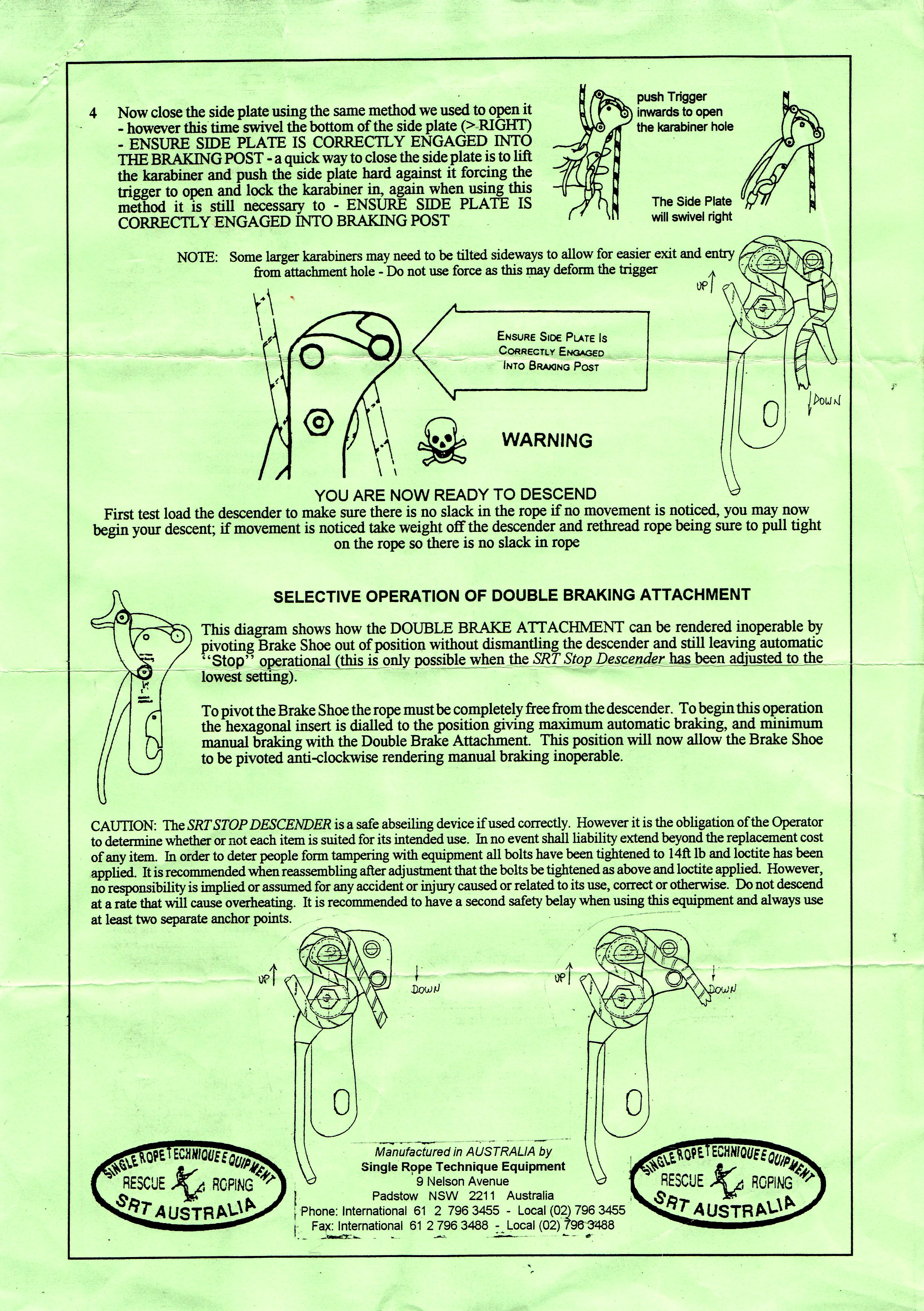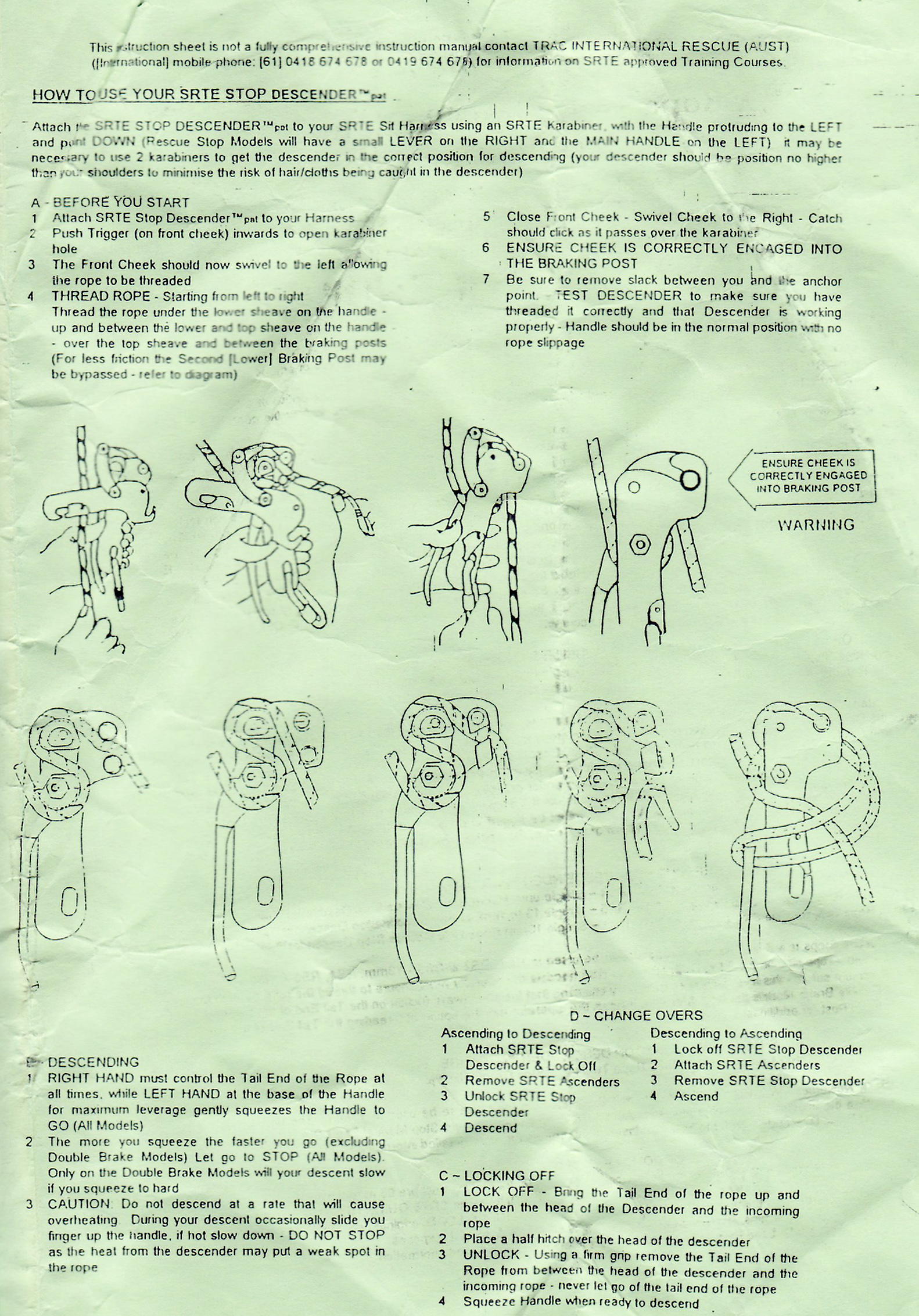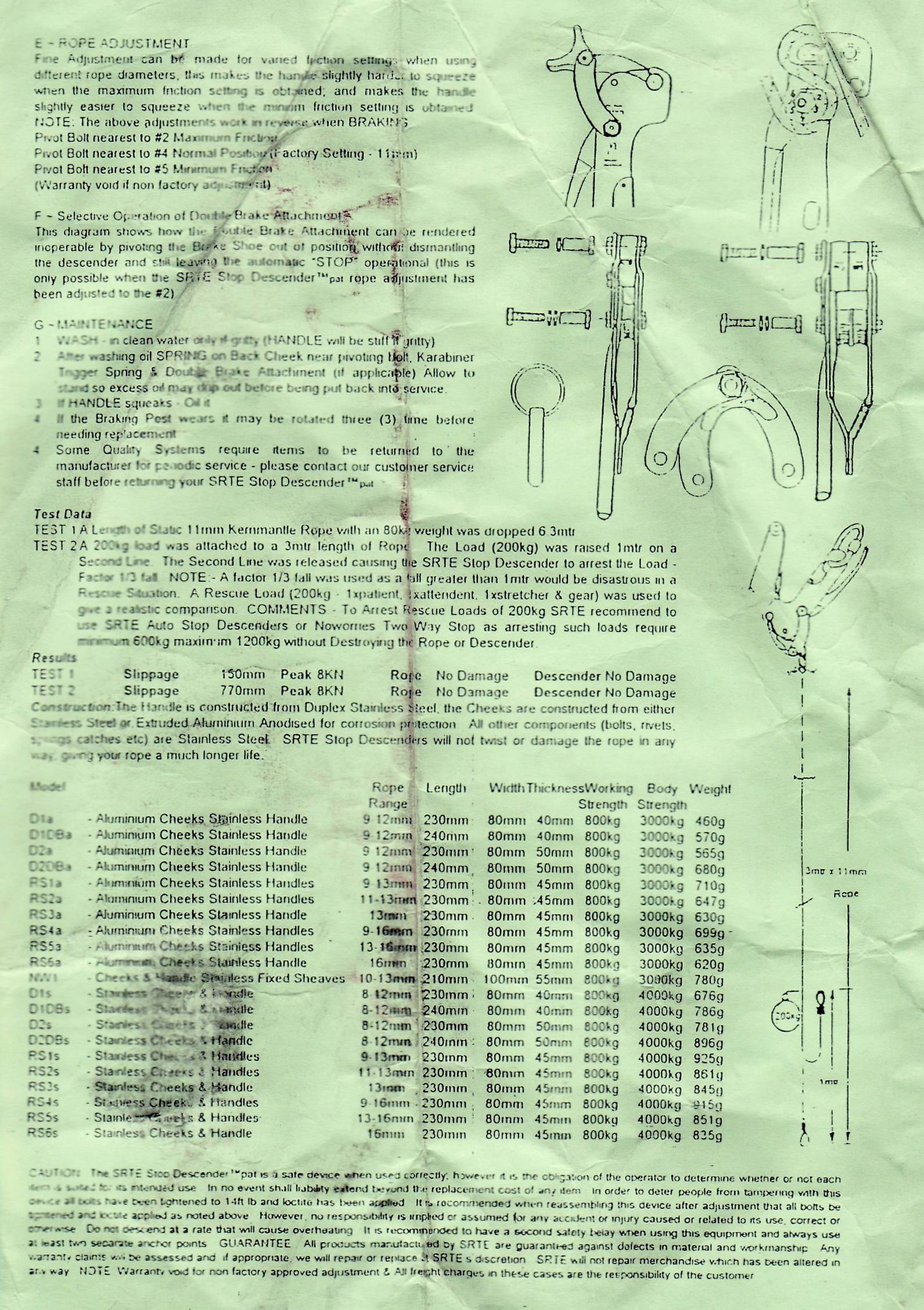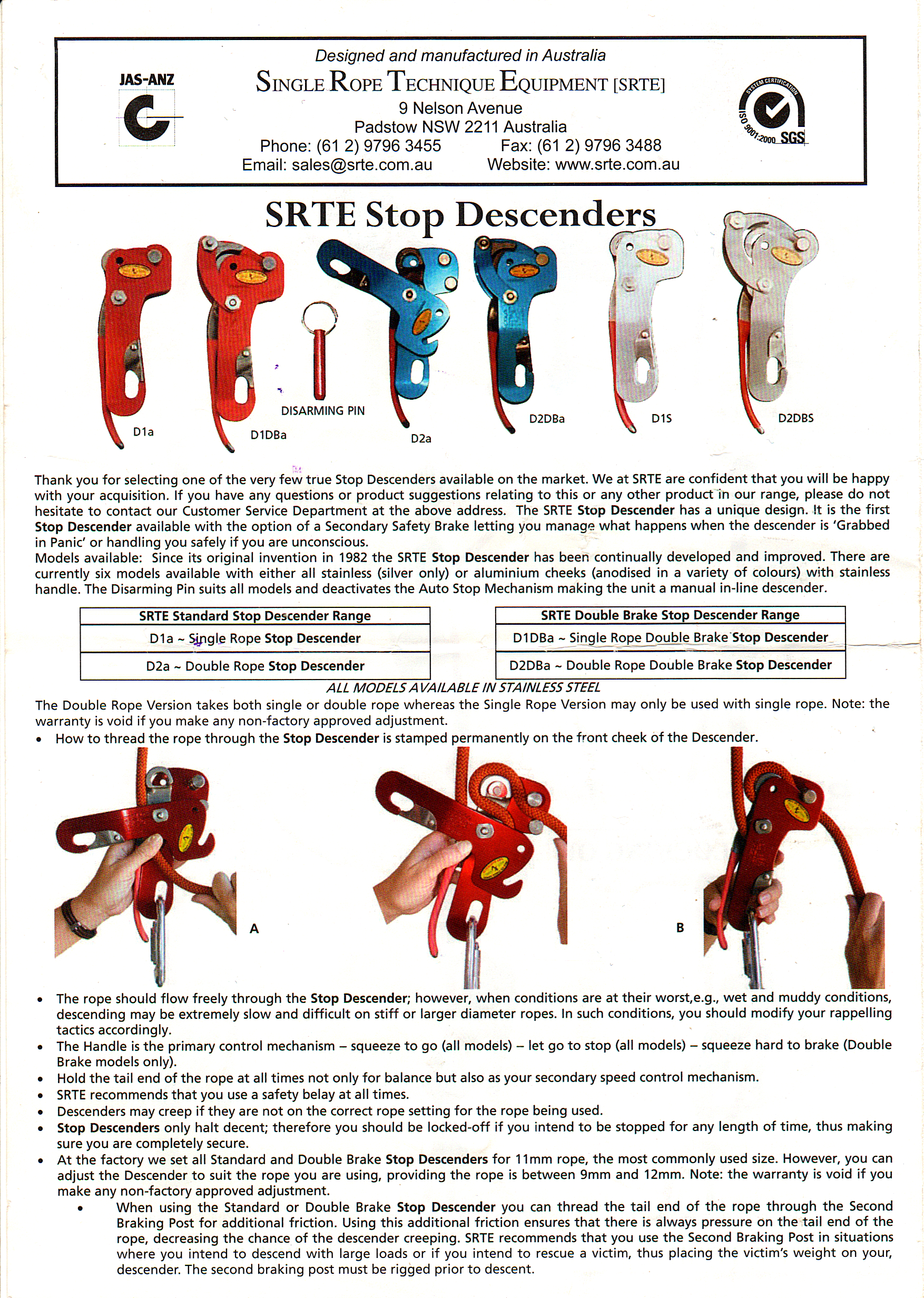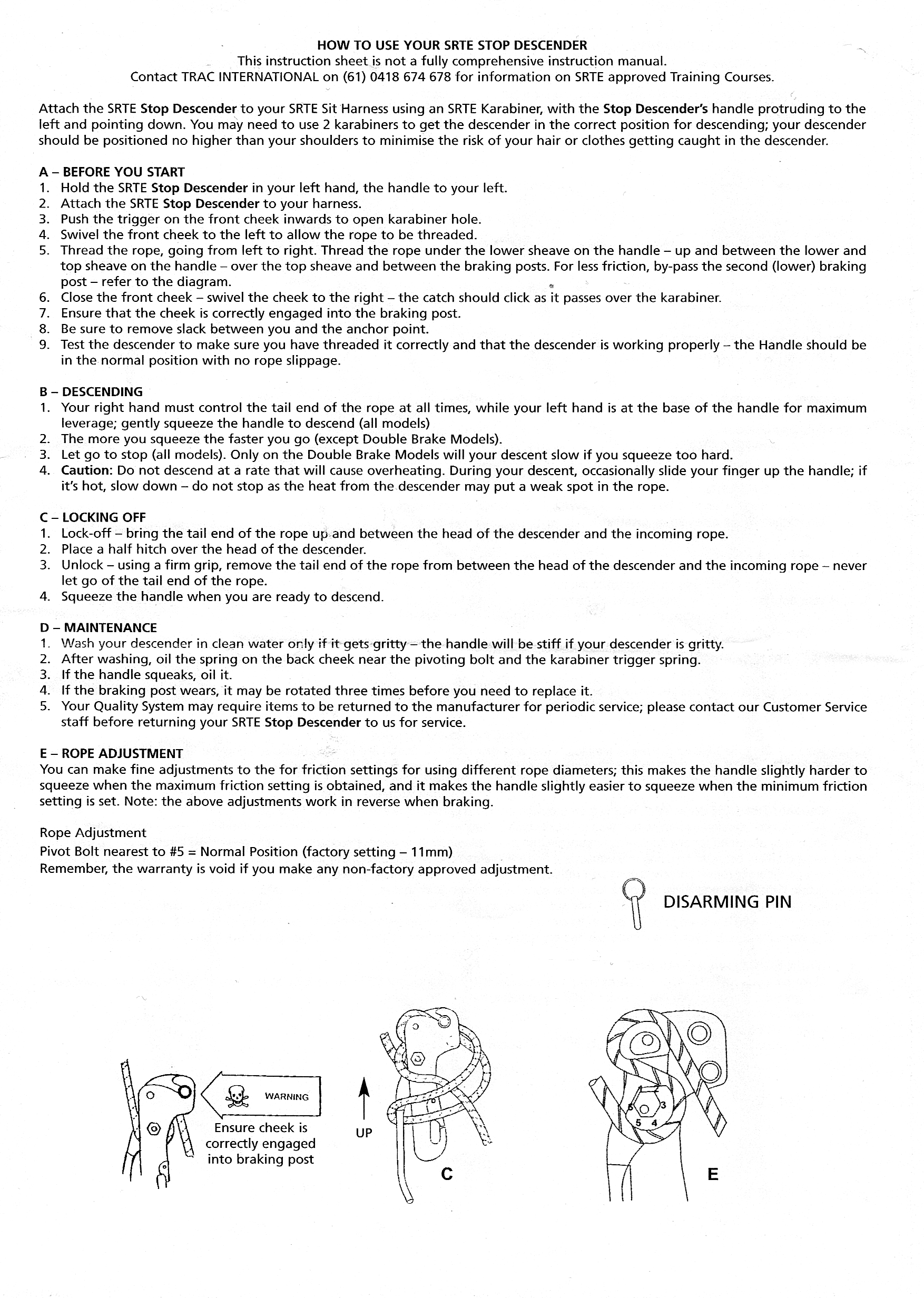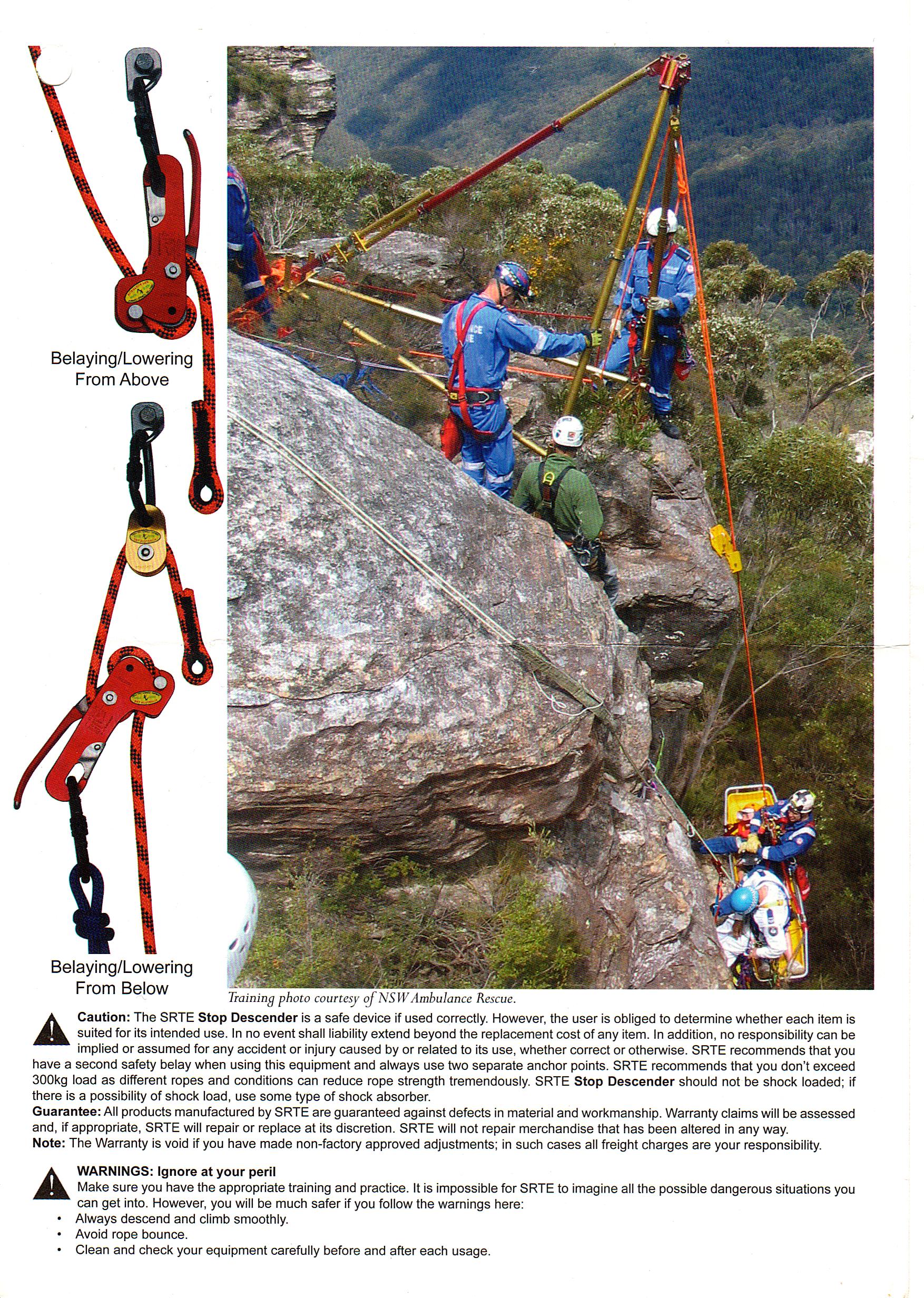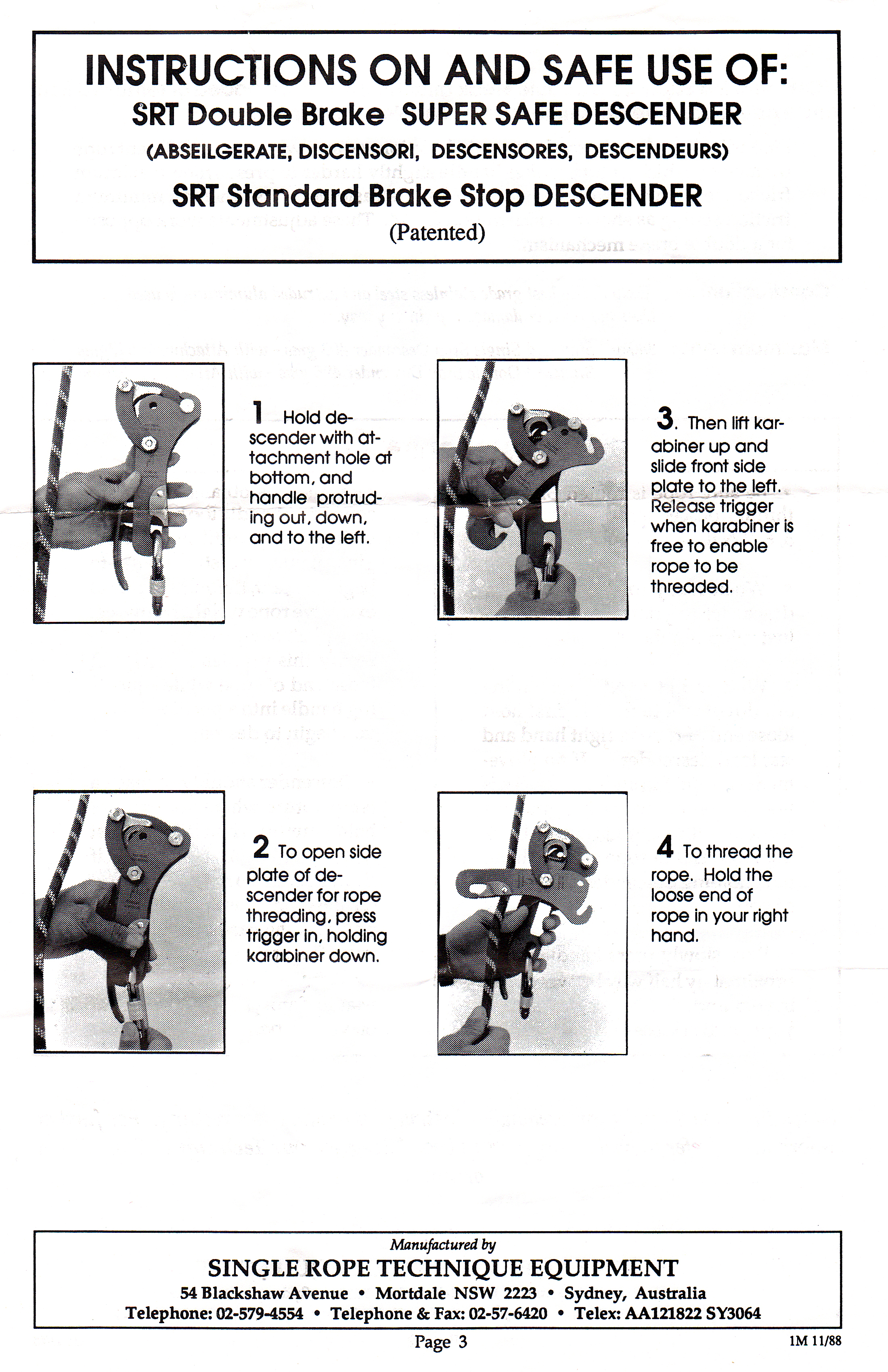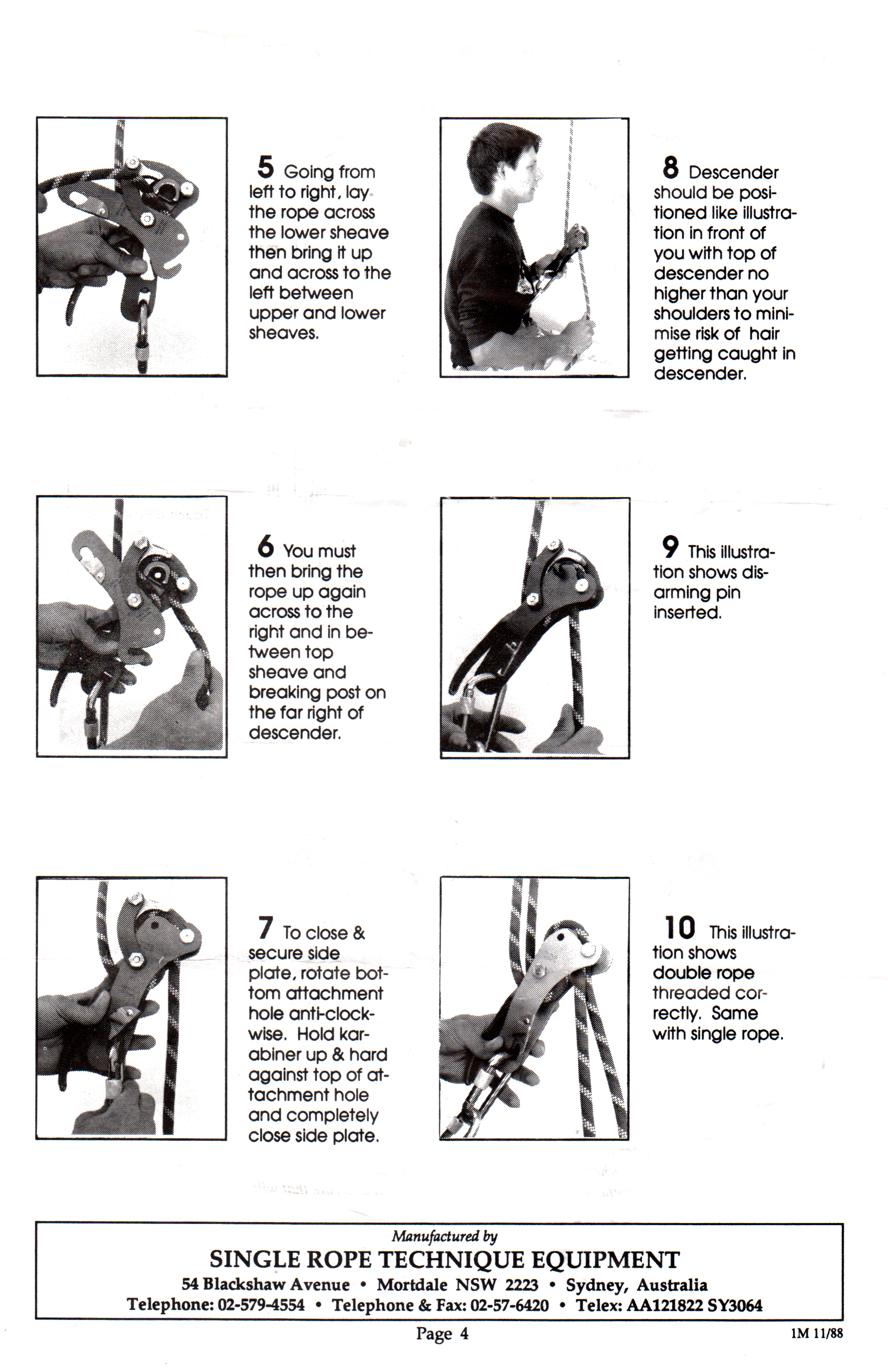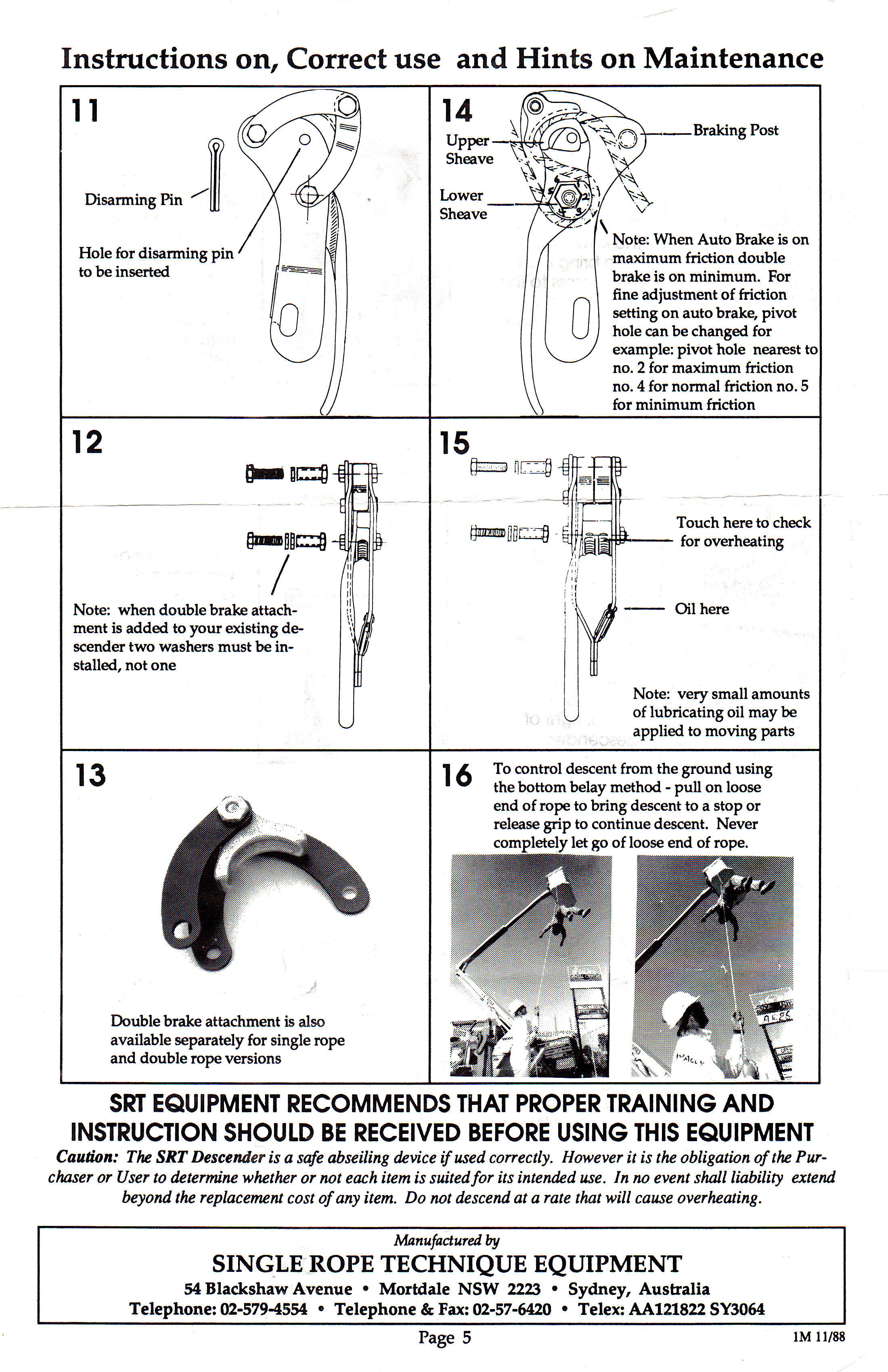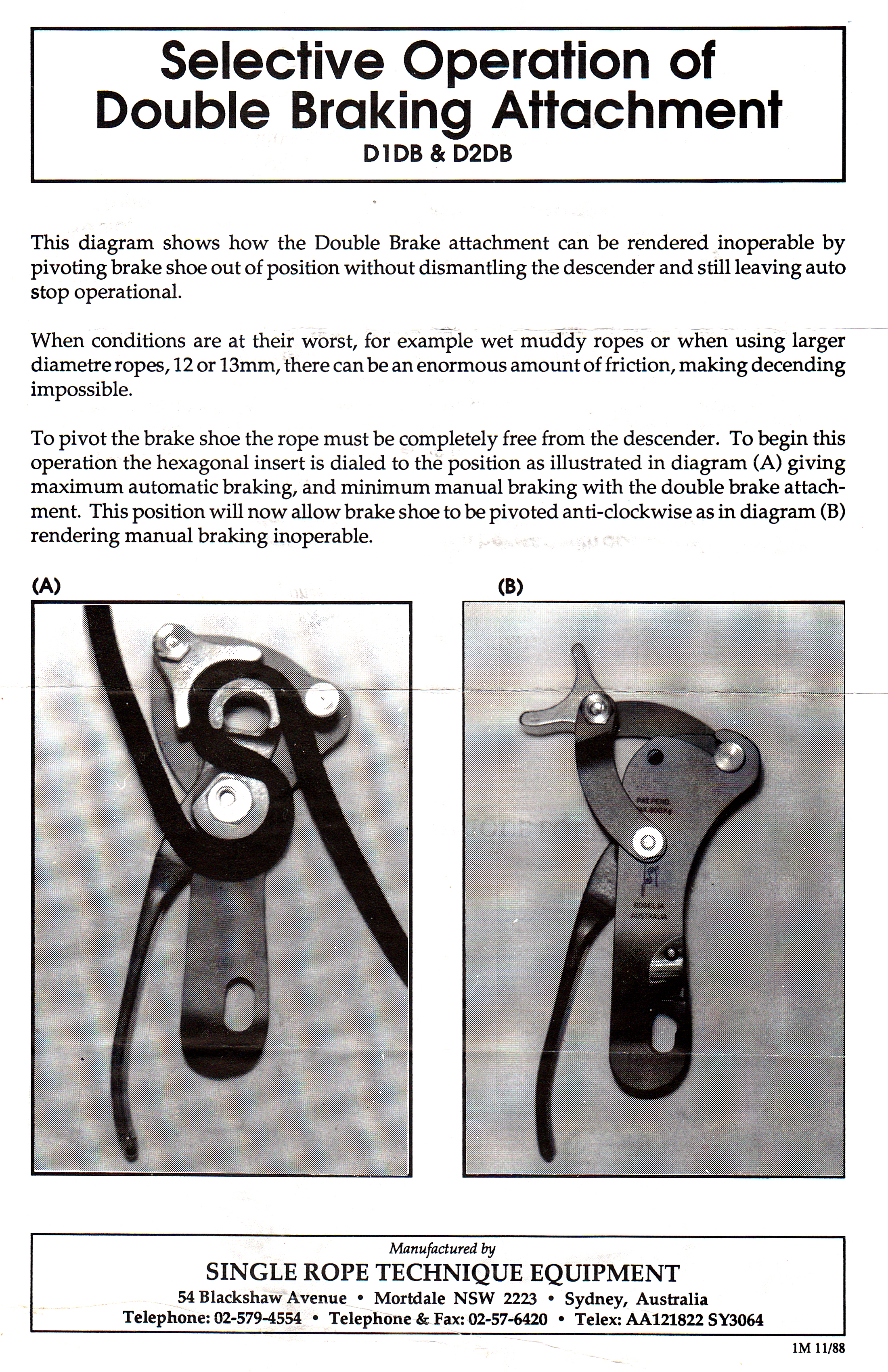Overview
History
Boris Rogelja founded Single Rope Technique Equipment (SRTE) in 1980. Capital Safety Group acquired SRTE in 2011 and their devices started showing DBI-SALA, Capital Safety, and/or Rollgliss™ markings. Some of these continued to show SRTE markings, and some did not. There does not appear to be a specific date when the markings disappeared. Different devices removed the SRTE logo at different times. 3M acquired the Capital Safety Group in 2015 and the Single Rope Technique Equipment markings disappeared completely. Since the device designs and construction retained continuity while the branding changed, I see no reason to put the different brands on separate pages.
The 2000 Single Rope Technique Equipment catalog listed 20
different versions of their stop bobbin, and if you include double
brake attachments on the rescue stops (RS models), the total would
be 32. Adding older and newer designs would greatly increase the
number of variations. I don't expect to collect them all, but
I can show a fair cross-section of the previous and current models
here.
[ Top
| D1 Version B
| D1a v. A
| D1a v. B
| D1a v. C
| D1s
| D1DB
| DS1
| D2 v. A
| D2 v. B
| D2a
| D2DB
| RS1a
| RS2a
| RS6DBs
| Return to Bobbins
]
D1, Version A
(#1023)
Technical Details
I acquired this D1 used from Tom Vines in 2006, but it dates
from the 1980s.
My D1 Version A is 220 mm. tall, 73 mm. wide, 36 mm. thick, and weighs 407 g.
The main differences between this one and D1 Version B
are the tubular plastic handgrip (also seen on D2 Version B),
and the details of the handle casting, particularly around the
upper bollard. The rope groove on Version A has more of a
V-shape than the U-shaped groove on Version B, and the eye
on Version A is smaller and more rounded than the D-shaped
eye on Version B.
[ Top
| D1 Version A
| D1a v. A
| D1a v. B
| D1a v. C
| D1s
| D1DB
| DS1
| D2 v. A
| D2 v. B
| D2a
| D2DB
| RS1a
| RS2a
| RS6DBs
| Return to Bobbins
]
D1, Version B
(#445, 2424)
Technical Details
I acquired this descender from Inner Mountain at OTR in 1988. I acquired two more in 2017 as part of Bob Thrun’s collection.
My D1, Version B is 225 mm. tall, 75 mm. wide, 35 mm. thick, and weighs 407 g.
The SRT differs from other bobbins in that both bollards and
the autostop handle are part of a single ferrous casting. This
casting is mounted between a fixed and a pivoting side plate.
The side plates are 3.3 mm. red anodized aluminum. The attachment
points are essentially the same as those on the quick attach bobbins,
and feature a similar guard on the pivoting side plate. The side
plates extend outwards (opposite the handle side) at the top,
and a 16 mm. cylinder is bolted to the fixed side plate.
A notch in the pivoting side plate mates with a notch in this
cylinder when the side plate is closed. The bollard casting pivots
about a nut passing through the lower bollard. On rappel the bollard
casting tends to pivot and force the upper bollard towards the
anvil, squeezing the rope and ideally arresting the descent. The
required torque is provided by the friction generated by the ropes
passage augmented by the asymmetrical loading resulting from the
"S" curve in the rope. A hole at the top of each side
plate is aligned with a hole in the upper bollard, and allows
insertion of a carabiner to prevent this rotation and deactivate
the autostop feature.
The pivot deserves some special discussion. Rather than simply
drill a pivot hole in the lower bollard, SRT casts a hexagonal
cavity into the bollard. A hexagonal aluminum bushing with an
off center hole can be placed into this cavity in six different
ways, thus moving the fulcrum with respect to the handle. A spring
is also provided to hold the handle open during storage, and functions
in the same manner as on the Petzl Stop.
The pivoting side plate is stamped with an icon illustrating
how the descender is threaded, but anyone who needs this assistance
shouldn't be using a bobbin anyhow. It is also stamped "PAT.
PEND," "MAX. 800 Kg," "ROGELJA," and
"AUSTRALIA." The pivot bolt head is marked "IVS"
and "A2." The anvil bolt head is marked "A2-70."
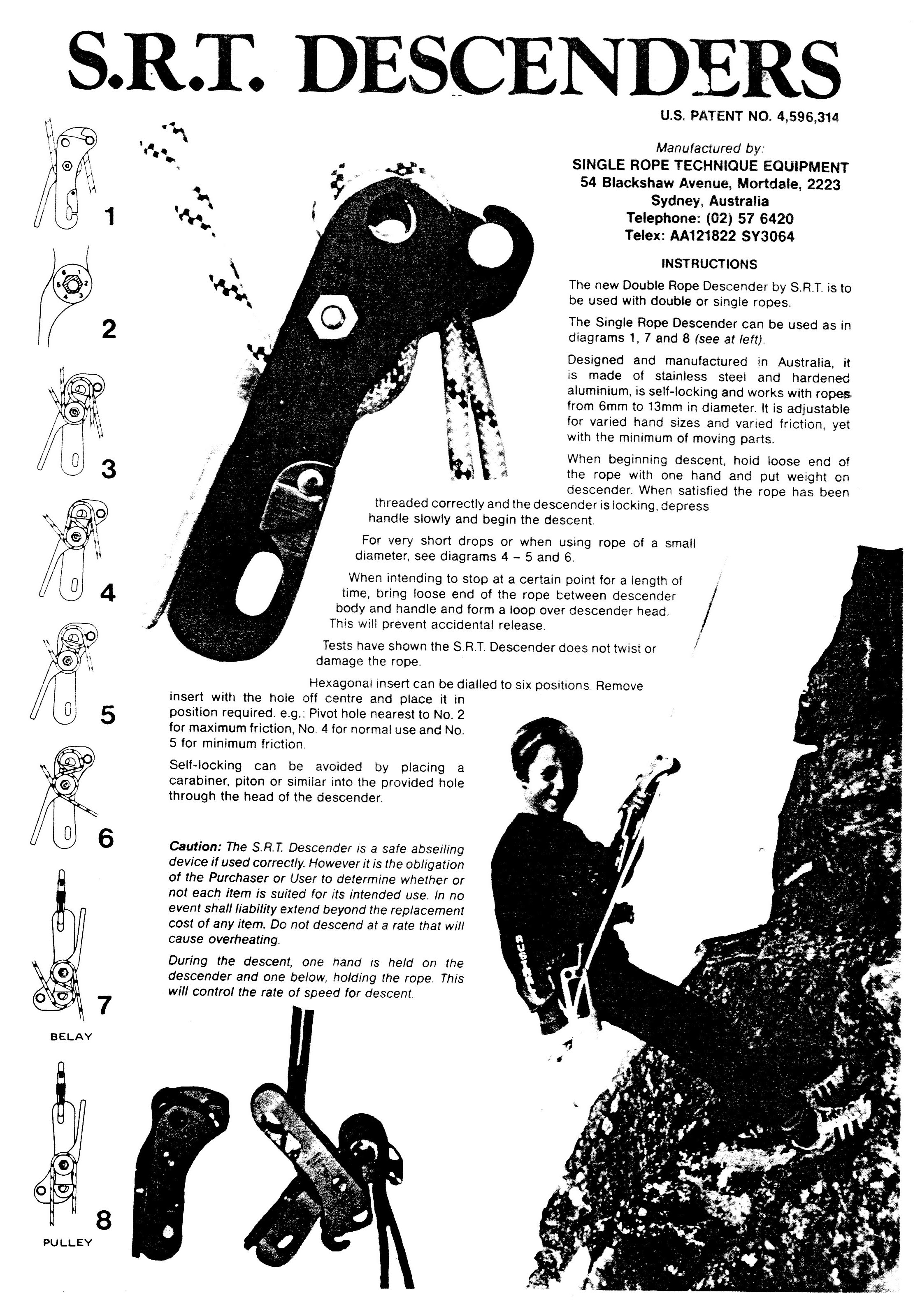 The descender seems to provide about the same amount of friction
as most bobbins, so is fast for my taste. The good news is the
autostop feature holds securely. The bad news is that it takes
quite a bit of effort to hold the handle to keep the autostop
disengaged. The reason is that squeezing the handle causes rotation
which lifts the upper bollard, and the trailing rope with it.
In fact, if one stops then uses the other hand to apply a strong
hip brake, squeezing the handle actually lifts the rappeller upwards.
The result is that one’s handle hand becomes tired very quickly.
The descender seems to provide about the same amount of friction
as most bobbins, so is fast for my taste. The good news is the
autostop feature holds securely. The bad news is that it takes
quite a bit of effort to hold the handle to keep the autostop
disengaged. The reason is that squeezing the handle causes rotation
which lifts the upper bollard, and the trailing rope with it.
In fact, if one stops then uses the other hand to apply a strong
hip brake, squeezing the handle actually lifts the rappeller upwards.
The result is that one’s handle hand becomes tired very quickly.
I tried varying the friction by rotating the internal hex bushing
as indicated in the instructions. It is a fairly easy task to
make the switch, but I could notice no differences on rappel.
Despite the documentation, I doubt that the hex bushing affects
friction much at all, since the relative location of the two bollards
is fixed, and that should control the friction. I was hoping that
the force required to hold the handle down would vary, since the
fulcrum is being moved, but in all cases the force required was
so high that I could not notice any change. If I were redesigning
this bobbin I would consider moving the third anvil up and closer
to the other two, possibly sacrificing some holding power for
ease of use.
The bollards themselves are ferrous rather than aluminum, so
they should be expected to heat more. I noticed this in qualitative
testing, but have not had the opportunity to quantify the difference.
The basic SRT Stop Bobbin is protected by U.S. Patent #4,596,314, but the more modern
design (specifically the D1a) shows up in U.S. Patent #5,954,153. Boris Rogelja holds
these patents, which explains the stamping on the side plate.
There are several other interesting patents, but I'm saving them
until I get the specific versions of these bobbins to test.
In general this bobbin is very well made, and the autostop
functions well, but it is very tiring to use.
[ Top
| D1 Version A
| D1 Version B
| D1a v. B
| D1a v. C
| D1s
| D1DB
| DS1
| D2 v. A
| D2 v. B
| D2a
| D2DB
| RS1a
| RS2a
| RS6DBs
| Return to Bobbins
]
D1a, Version A
(#519)
Technical Details
I acquired this D1a from Inner Mountain Outfitters in 1996.
My D1a, Version A is 227 mm. tall, 79 mm. wide, 37 mm. thick, and weighs 467 g.
This is another version of the D1, with a different side
plate design and an additional cylinder bolted inside the frame.
Under the new numbering scheme, the "a" in D1a means
aluminum side plates. This is the design shown in in U.S. Patent #5,954,153.
Note the disarming pin that keeps the stop feature from activating.
This was an optional item that I chose to install on this descender, mainly because this on had the proper size holes in the plated. The disarming pin does not have a spring-loaded ball, so it tends
to fall out if one isn't careful.
[ Top
| D1 Version A
| D1 Version B
| D1a v. A
| D1a v. C
| D1s
| D1DB
| DS1
| D2 v. A
| D2 v. B
| D2a
| D2DB
| RS1a
| RS2a
| RS6DBs
| Return to Bobbins
]
D1a, Version B
(#1274)
Technical Details
I acquired this D1a from Addie Mannan in 2010.
My D1a, Version B is 227 mm. tall, 83 mm. wide, 37 mm. thick, and weighs 466 g.
Version B uses a different front nut than Version A.
[ Top
| D1 Version A
| D1 Version B
| D1a v. A
| D1a v. B
| D1s
| D1DB
| DS1
| D2 v. A
| D2 v. B
| D2a
| D2DB
| RS1a
| RS2a
| RS6DBs
| Return to Bobbins
]
D1a, Version C
(#2560)
Technical Details
I acquired this DBI-SALA/Rollgliss/SRTE D1a from Lance Swartwout in 2020.
This D1a is 225 mm. tall, 79 mm. wide, 37 mm. thick, and weighs 466 g.
The front is printed with "Rollgliss®," "8700068," "D1a," the DBI/SALA logo, the SRTE logo, "MBS 5kN," "MAX. DESCENT 150m," "MIN. TEMPERATURE -38c," "MIN. 30 kg MAX 200kg," "RopeO10.5mm ≤Ø≤13mm," a caution icon, a book-with-an-"i" icon, "WARNING," "PROPER TRAINING IS ESSENTIAL," "D.O.M.," "Oct 2013," "Serial #," "249182-08," "CE 2056," "EN 341," "AS/NZS 4488," "MEETS NDPA 1983 (2006 ED)L," Lic SMKH25365," a rigging illustration, "Made under a quality cheme certified by SAI GLOBAL," and an SAI Global certified product icon.
The two bolts holding the bollards have heads marked "TD" and "A2-70" in raised characters. The axle bolt head has "A2-70" and "TRE" in raised characters.
This version does not have any stamped markings; otherwise, it is essentiall identical to Version B.
[ Top
| D1 Version A
| D1 Version B
| D1a v. A
| D1a v. B
| D1a v. C
| D1DB
| D2 v. A
| D2 v. B
| D2a
| D2DB
| RS1a
| RS2a
| RS6DBs
| Return to Bobbins
]
D1s
(#1451)
DBI-SALA/Rollgliss/SRTE
Technical Details
I acquired my DBI-SALA/Rollgliss/SRTE D1s from Amazon.com in 2015.
My DBI-SALA/Rollgliss/SRTE D1s is 224 mm. tall, 83 mm. wide, 37 mm. thick, and weighs 702 g.
The front is etched with "Rollgliss®," "8700070," "D1s," the DBI/SALA logo, the SRTE logo, a caution icon, a book-with-an-"i" icon, "MBS 8kN," "MAX. DESCENT 150m," "MIN. 30 kg MAX 200kg," "WARNING," "PROPER TRAINING IS ESSENTIAL," "D. O. M. Oct 2013," "SERIAL # 249183-30," "CE 2056," "EN 341," "AS/NZS 4488," "MEETS NFPA 1983 (2006 ED)L," "Lic SMKH25365," a rigging illustration, "Made under quality scheme certified by SAI GLOBAL," and a certified product icon. The cam has "SRT" cast in raised letters.
This is a stainless steel descender. The weight is excessive for recreational use, and the extensive reading material on the front plate needs a more interesting plot.
[ Top
| D1 Version A
| D1 Version B
| D1a v. A
| D1a v. B
| D1a v. C
| D1s
| DS1
| D2 v. A
| D2 v. B
| D2a
| D2DB
| RS1a
| RS2a
| RS6DBs
D1DB
(#446, 2425)
Technical Details
I acquired this D1DB from Single Rope Technique Equipment in 1989. I acquired another in 2017 as part of Bob Thrun’s collection.
My Single Rope Technique Equipment D1DB is 245 mm. tall, 98 mm. wide, 41 mm. thick, and weighs 523 g.
This is a newer version of the D1 with a double-brake
attachment added. The basic descender has eliminated the carabiner
hole seen on the D1 and replaced it with an 8 mm. hole for
a pin. Inserting the pin overrides the autostop feature. Unfortunately,
the pin hole was only drilled in the fixed side plate. This is
an obvious oversight in manufacturing that does not reflect well
on the manufacturer’s quality control at the time.
The double-brake feature adds a brake shoe so that over-squeezing
the handle, such as a person might irrationally do while panicking,
adds friction in an attempt to stop the rappeller. Naturally,
there will not be enough friction if the rappeller is not panicked
enough. The double-brake feature adds considerable weight to the
basic device. It can be defeated by rotating the shoe out of the
way, but only if the descender has been adjusted to the lowest
setting of the hexagonal insert. It can also be removed, although
one might need to find shorter bolts if they choose to do so.
[ Top
| D1 Version A
| D1 Version B
| D1a v. A
| D1a v. B
| D1a v. C
| D1s
| D1DB
| D2 v. A
| D2 v. B
| D2a
| D2DB
| RS1a
| RS2a
| RS6DBs
| Return to Bobbins
]
DS1
(#1111)
Technical Details
I acquired my DS1 used from Richard Wolle in 2007.
My Single Rope Technique Equipment DS1 is 226 mm. tall, 75 mm. wide, 37 mm. thick, and weighs 711 g.
This version is similar to the D1a Version A
except that it has stainless steel side plates. This is the only
STRE in my collection that does not have a handle cover, but one
might have been removed by the previous owner.
[ Top
| D1 Version A
| D1 Version B
| D1a v. A
| D1a v. C
| D1a v. B
| D1s
| D1DB
| DS1
| D2 v. B
| D2a
| D2DB
| RS1a
| RS2a
| RS6DBs
| Return to Bobbins
]
D2 v. A
(#447)
Technical Details
I acquired this D2 from Raven Products in 1990.
My Single Rope Technique Equipment D2, Version A is 222 mm. tall, 73 mm. wide, 46 mm. thick, and weighs 498 g.
This version is for double rope. It represents an early
design. Not only is the handle different, but the handle assembly
differs from the one in D2 Version B, particularly in the
area of the top bollard.
[ Top
| D1 Version A
| D1 Version B
| D1a v. A
| D1a v. B
| D1a v. C
| D1s
| D1DB
| DS1
| D2 v. A
| D2a
| D2DB
| RS1a
| RS2a
| RS6DBs
| Return to Bobbins
]
D2 v. B
(#448, 2423)
Technical Details
I acquired this D2 from Single Rope Technique Equipment in 1989. I acquired another in 2017 as part of Bob Thrun’s collection.
My Single Rope Technique Equipment D2, Version B is 222 mm. tall, 73 mm. wide, 46 mm. thick, and weighs 509 g.
This is a later version double rope descender. It was subsequently
replaced by the current model, which has a frame similar to the
D1a. Note the disarming pin that keeps the stop feature from activating.
The disarming pin does not have a spring-loaded ball, so it tends
to fall out if one isn't careful. The older Version A had
a carabiner hole that served the same purpose.
[ Top
| D1 Version A
| D1 Version B
| D1a v. A
| D1a v. B
| D1a v. C
| D1s
| D1DB
| DS1
| D2 v. A
| D2 v. B
| D2DB
| RS1a
| RS2a
| RS6DBs
| Return to Bobbins
]
D2a
(#1455)
DBI-SALA/Rollgliss/Capital Safety
Technical Details
I acquired my DBI-SALA/Rollgliss/Capital Safety D2a from Amazon.com in 2015.
My DBI-SALA/Rollgliss/Capital Safety D2a is 226 mm. tall, 80 mm. wide, 48 mm. thick, and weighs 567 g.
The front is etched with the DBI/SALA logo, "Rollgliss®," "CAPITAL SAFETY," "www.capitalsafety.com," "MBS 5kN," "MAX. DESCENT 150m," "MIN. TEMPERATURE -38c," "MIN. 30 kg MAX 200kg," "RopeO10.5mm ≤Ø≤13mm," an SAI Global certified product icon, an SAI Global Certified System icon, "AS/NZS 4488.2-97," "Lic SMKH25365,"MEETS NFPA 1983 (2012 ED)T, "Lic SMKH25315," "SERIAL # 313001-04," "D. O. M. Mar 2015," a rigging illustration, a caution icon, a book-with-an-"i" icon, and "WARNING," "PROPER TRAINING IS ESSENTIAL." The cam has "SRT" cast in raised letters.
Once again, the weight is excessive for recreational use, and the extensive reading material on the front plate needs a more interesting plot.
[ Top
| D1 Version A
| D1 Version B
| D1a v. A
| D1a v. B
| D1a v. C
| D1s
| D1DB
| DS1
| D2 v. A
| D2 v. B
| D2a
| RS1a
| RS2a
| RS6DBs
| Return to Bobbins
]
D2DB
(#449)
Technical Details
I acquired this D2DB from John E. Weinel, Inc. in 1989.
My Single Rope Technique Equipment D2DB is 245 mm. tall, 98 mm. wide, 52 mm. thick, and weighs 631 g.
This double-rope version has a double-brake attachment
added. I acquired another double-brake attachment kit in 2017 as part of Bob Thrun’s collection.
[ Top
| D1 Version A
| D1 Version B
| D1a v. A
| D1a v. B
| D1a v. C
| D1s
| D1DB
| DS1
| D2 v. A
| D2 v. B
| D2a
| D2DB
| RS2a
| RS6DBs
| Return to Bobbins
]
RS1a
(#573)
Technical Details
I acquired this RS1a from Single Rope Technique Equipment in 2000.
My Single Rope Technique Equipment RS1a is 227 mm. tall, 84 mm. wide, 43 mm. thick, and weighs 716 g.
The RS1a is an aluminum-frame rescue stop bobbin designed for
9 to 13 mm. rope. The friction post is free-swinging. It
has two notches that the rope can be fed through. Not only does
this provide friction on the trailing end of the rope, but it
also squeezes the rope between the friction post and the bollards.
The friction post design is protected by U.S. Patent #5,597,052.
[ Top
| D1 Version A
| D1 Version B
| D1a v. A
| D1a v. B
| D1a v. C
| D1s
| D1DB
| DS1
| D2 v. A
| D2 v. B
| D2a
| D2DB
| RS1a
| RS6DBs
| Return to Bobbins
]
RS2a
(#574)
Technical Details
I acquired this RS2a from Single Rope Technique Equipment in 2000.
My RS2a is 227 mm. tall, 83 mm. wide, 43 mm. thick, and weighs 654 g.
The RS2a is similar to the RS1a, except that the friction post
is cut short and only one notch is available. This means that
less friction is available, so Single Rope Technique Equipment specifies
a rope range of 11 to 13 mm. for this descender.
[ Top
| D1 Version A
| D1 Version B
| D1a v. A
| D1a v. B
| D1a v. C
| D1s
| D1DB
| DS1
| D2 v. A
| D2 v. B
| D2a
| D2DB
| RS1a
| RS2a
| Return to Bobbins
]
RS6DBs
(#575)
Technical Details
I acquired this RS6DBs from Single Rope Technique Equipment in 2000.
My Single Rope Technique Equipment RS2a is 227 mm. tall, 83 mm. wide, 43 mm. thick, and weighs 654 g.
This is a double-rope version designed for 16 mm.
rope. The frame is stainless steel (all current Single Rope Technique Equipment
bobbins come in both aluminum and stainless steel versions). I
had a double-brake attachment added to this one. The lower bollard
rotates, much like a pulley, which helps reduce the friction normally
encountered with the oversize ropes used by the "bigger is better" crowd. There are two
subsidiary bollards for those who want to increase the friction.
For some reason, the hole for the disarming pin does not line
up with the hole in the upper bollard, so the pin cannot be used.
[ Top
| D1 Version A
| D1 Version B
| D1a v. A
| D1a v. B
| D1a v. C
| D1s
| D1DB
| DS1
| D2 v. A
| D2 v. B
| D2a
| D2DB
| RS1a
| RS2a
| RS6DBs
]



